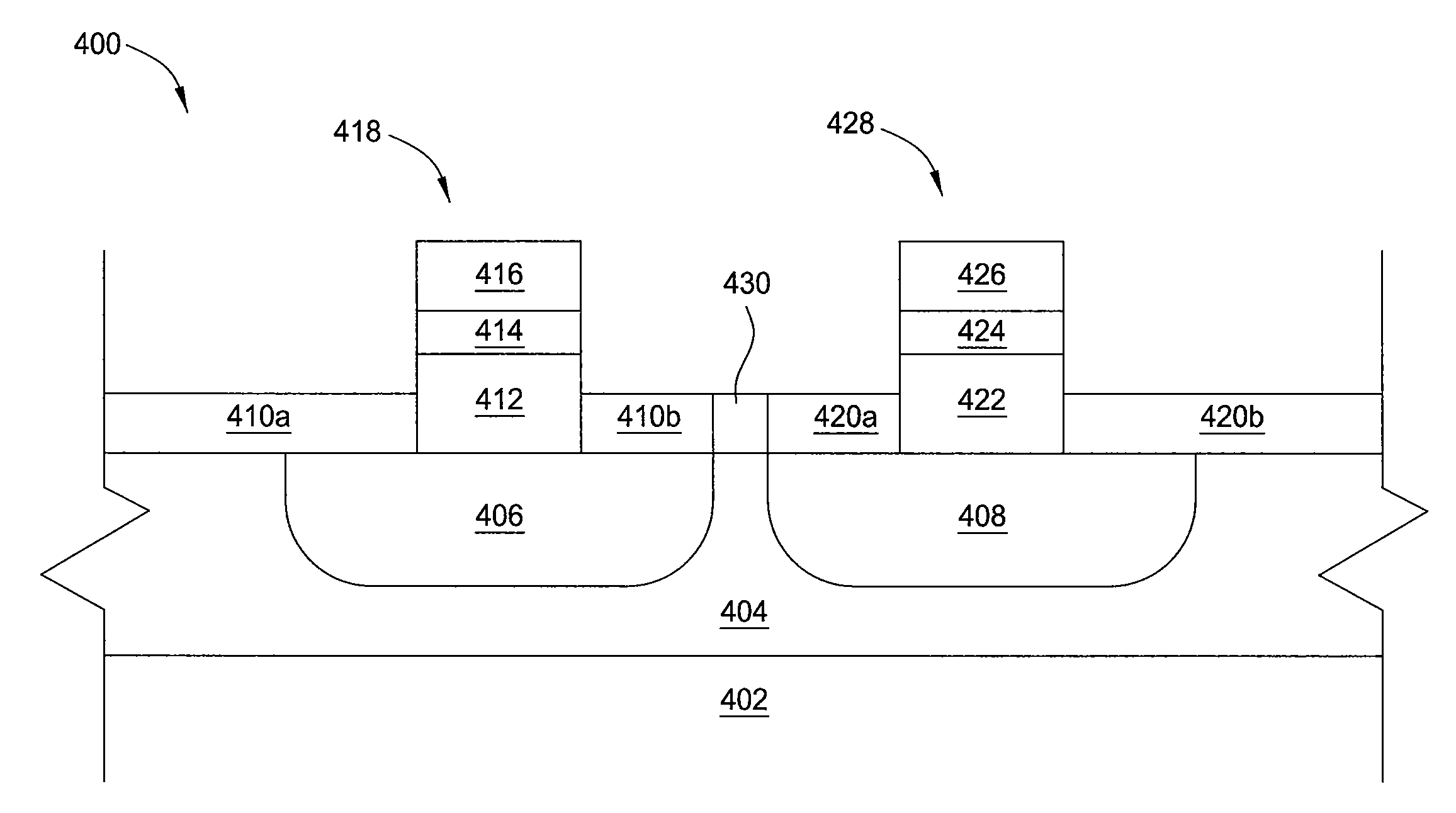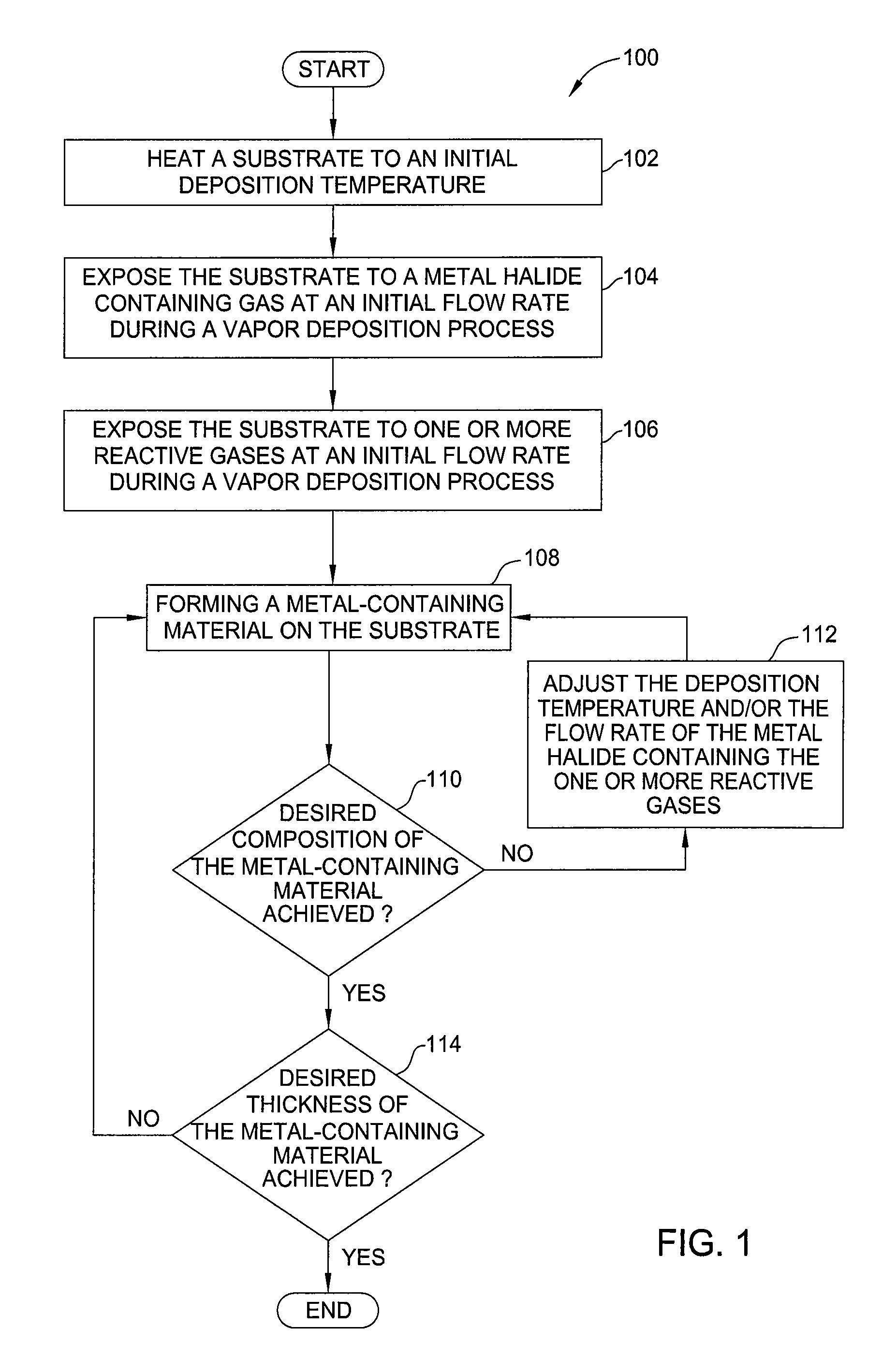Nmos metal gate materials, manufacturing methods, and equipment using CVD and ald processes with metal based precursors
a technology of metal gate electrodes and manufacturing methods, which is applied in the direction of chemical vapor deposition coatings, coatings, semiconductor devices, etc., can solve the problems of many cvd processes producing less than desired, tantalum materials only being scarcely used for metal gate electrode formation, and less than desirable electronic properties of materials used for gate electrodes
- Summary
- Abstract
- Description
- Claims
- Application Information
AI Technical Summary
Problems solved by technology
Method used
Image
Examples
example 1
[0103]PE-ALD—A tantalum layer may be deposited on a substrate by a PE-ALD process. The substrate and the substrate pedestal were heated to a temperature of about 250° C. The substrate was sequentially exposed to a tantalum halide precursor, TaF5, an argon purge gas, a hydrogen plasma gas and a plasma is generated, and the argon purge gas during a PE-ALD cycle. The PE-ALD cycle exposed the substrate to the tantalum precursor gas for about 5 seconds, and the purge gas for about 2 seconds, and a hydrogen gas in which a plasma was generated at 400 watts and exposed the substrate for 10 seconds. The tantalum precursor gas had a flow rate of about 3 sccm of TaF5 in about 250 sccm of argon carrier gas. The tantalum material was deposited on the substrate to a final thickness of about 10 Å by 20 cycles of about 0.5 Å with each cycle lasting about 20 seconds.
[0104]The composition analysis of the tantalum material provided a resistivity of less than 200 μΩ-cm, such as from 130 μΩ-cm to less t...
example 2
[0105]ALD—A hafnium aluminide carbide layer may be deposited on a substrate by an ALD process. The substrate and the substrate pedestal were heated to a temperature of about 500° C. The substrate was sequentially exposed to a hafnium halide precursor, HfCl4, a nitrogen purge gas, an aluminum precursor, triethylaluminum (TEA), tritertbutyl aluminum (TTBA), and / or trimethylaluminum (TMA) and a second nitrogen gas purge during an ALD cycle. The ALD cycle exposed the substrate to the hafnium precursor gas for about 10 seconds, a nitrogen gas purge for 10 seconds, exposed the substrate to TEA and / or TTBA for 5 seconds, and then a nitrogen gas purge for 5 seconds. The hafnium precursor gas had a flow rate of about 2 sccm of HfCl4 in about 250 sccm of argon carrier gas. The TEA and / or TTBA precursor had a flow rate of about 30 mg / minute. The hafnium alumunide material was deposited on the substrate to a final thickness of about 2 to 3 Å by 100 cycles of about 200 to about 300 Å with each c...
example 3
[0106]PE-ALD—A hafnium aluminide layer may be deposited on a substrate by an ALD process. The substrate and the substrate pedestal were heated to a temperature of about 500° C. The substrate was sequentially exposed to a hafnium halide precursor, HfCl4, a nitrogen purge gas, an aluminum precursor, triethylaluminum (TEA) and / or tritertbutyl aluminum (TTBA), and a second nitrogen gas purge, during an ALD cycle, and a plasma of hydrogen after one or more of the ALD cycles. The ALD cycle exposed the substrate to the hafnium precursor gas for about 10 seconds, a nitrogen gas purge for 10 seconds, exposed the substrate to TEA and / or TTBA for 5 seconds, and then a nitrogen gas purge for 5 seconds. The hafnium precursor gas had a flow rate of about 2 sccm of HfCl4 in about 250 sccm of argon carrier gas. The aluminum precursor had a flow rate of about 30 mg / minute. The plasma gas was introduced at a flow rate of 2000 sccm and a plasma generated for about 10 seconds.
PUM
| Property | Measurement | Unit |
|---|---|---|
| work function | aaaaa | aaaaa |
| temperature | aaaaa | aaaaa |
| size | aaaaa | aaaaa |
Abstract
Description
Claims
Application Information
 Login to View More
Login to View More - R&D
- Intellectual Property
- Life Sciences
- Materials
- Tech Scout
- Unparalleled Data Quality
- Higher Quality Content
- 60% Fewer Hallucinations
Browse by: Latest US Patents, China's latest patents, Technical Efficacy Thesaurus, Application Domain, Technology Topic, Popular Technical Reports.
© 2025 PatSnap. All rights reserved.Legal|Privacy policy|Modern Slavery Act Transparency Statement|Sitemap|About US| Contact US: help@patsnap.com



